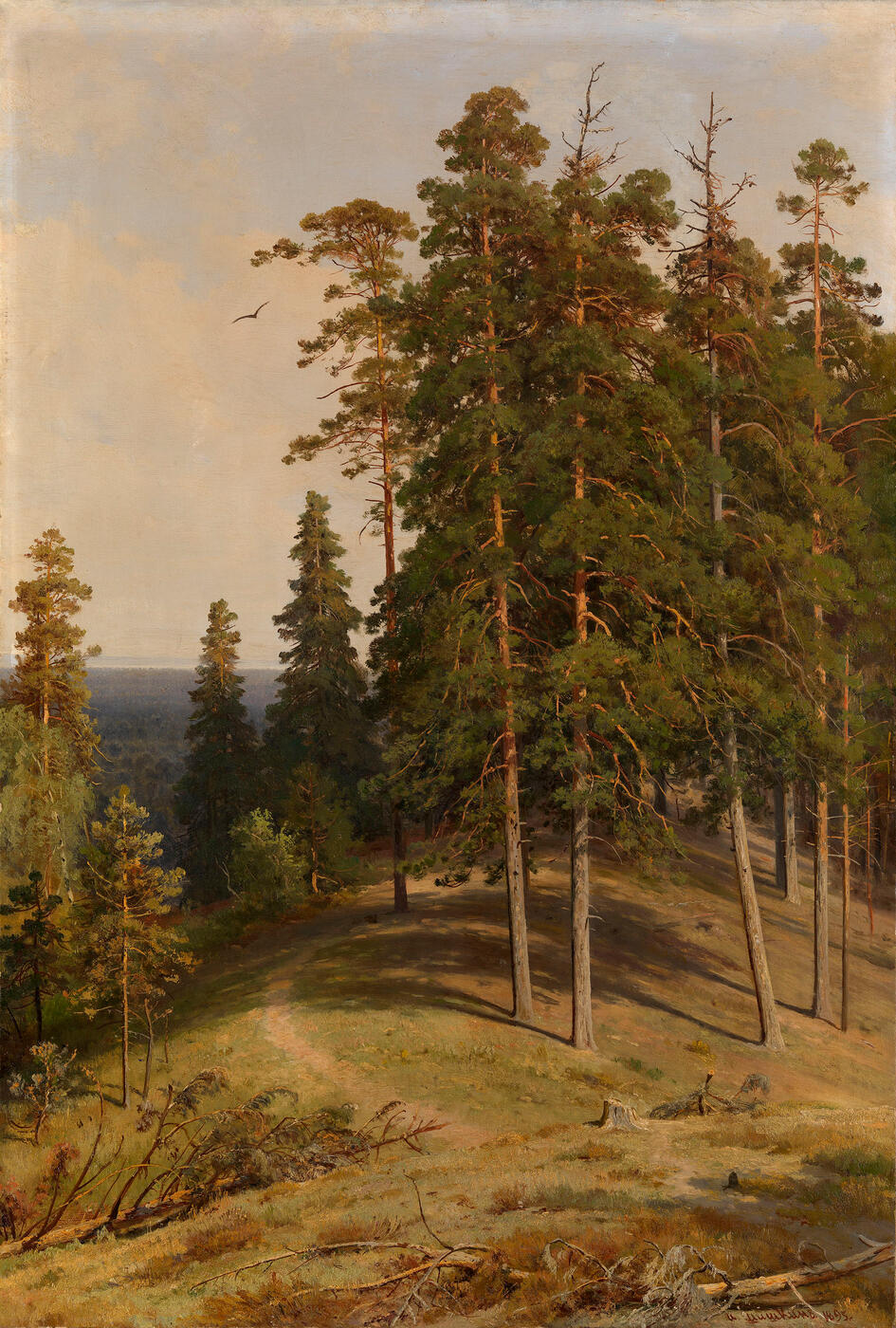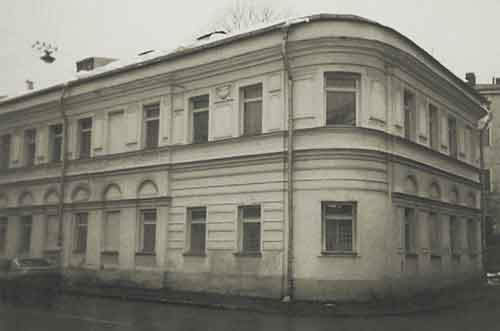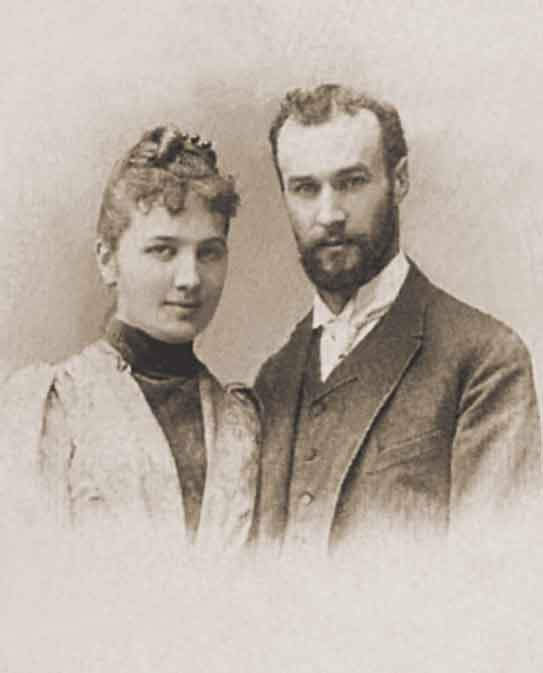MacDougall's Russian Art Auctions 8-9 June 2011
8 June 2011

24. SHISHKIN, IVAN (1832-1898)
The Pine Forest, signed and dated 1895.
Oil on canvas, 106 by 72 cm.
800,000-1,200,000 GBP
Provenance: Acquired by the court jeweller Wilhelm Bolin (1861-1934), possibly directly from the artist.
Thence by descent.
Acquired from the above by the present owner.
Private collection, Europe.
Authenticity of the work has been confirmed by the expert by V. Petrov.
Ivan Shishkin, the best-known and most highly-esteemed master of Russian landscape, painted The Pine Forest in 1895. At this time the artist was already at the peak of his fame and skill, and many highly-placed customers - industrialists and other wealthy entrepreneurs - were vying to acquire his work for their collections. One of these was Wilhelm Bolin, celebrated jeweller to the Tsar, who possibly commissioned this painting from Shishkin.
The forest edge, warmed by the sun, in the foreground; the group of slender pines on the wooded slope; the mass of trees, softened by a faint haze, which close up the expanse of the picture; and the bright summer sky with its covering of cloud- all give a sense of the peace and tranquillity of a summer day. Here there is no straining for a pretty motif or deliberately heightened mood, yet for all its simplicity The Pine Forest captivates us with the grandeur of the trees towering proudly against the sky and with the expressiveness of its artistic language.
During the 1880s and 1890s the artist often turned to the subject of pine forests. Shishkin had grown up in Yelabuga, among the pine-covered expanses of the Afonasov grove of ship-building timber, and more than any other artist he knew and loved the coniferous forest. The pine wood, which this master introduced to Russian painting, underwent a transformation in his works that was both of consummate technical skill and genuinely poetic. Outstanding pictures such as The Pine Forest, Path in a Forest, Pine Trees Lit by the Sun, Morning in a Pine Forest and The Forest of Countess Mordvinova allowed him not only to convey the beauty of those slender trees reaching skyward, but also to tackle head on the challenges of contemporary plein-air painting. In these works Shishkin pays ever greater attention to the problems of lighting, to conveying nature's varying states: his technique becomes freer, his brushstroke wider, the paint layers on the canvas lighter and thinner.
The Pine Forest provides an insight into the new qualities that distinguished Shishkin's work at this time. Here he found a brilliant solution to the challenge of reproducing the changing atmospheric conditions on canvas. The narrow pine trunks are adorned with the gold of sunlight, the warm summer sky is visible through the downy needles of the tall trees, and the whole expanse of the forest edge seems to be imbued with an aromatic, resinous air. The tree-branches, illuminated in this air, are rendered with fluid virtuosity. The brushstrokes glide, interweave and blend together, creating the impression of a living, moving carpet of grass along the path, slightly scorched by the strong sun. Shishkin does not attempt - as he often did before - to achieve a painstaking reproduction of all the botanical details. This work is painted with
a poetic freshness and spontaneity which gives a feeling of real palpability in the depiction of tree-trunks, of natural movement of the light and shade, of universality in the composition and of rigorous simplicity.
Every day, at exactly the same time, Shishkin went to his chosen spot and captured the subtle and variable state of the air, the light, the space around him, all the elements of the natural world, and the way they interrelate. Then he would labour over the picture in his studio. In The Pine Forest, the artist retains all the naturalness of the subject portrayed, achieving a harmonious whole. In his works of this period, we can see him striving to combine monumentality with lyricism, to express a spiritual connection with the natural environment.
The Pine Forest is very similar to the famous picture Forest Seen from a Hill (1895), which the collector Ivan Sveshnikov once donated to the Rumyantsev Museum in Moscow, and which is now in the Arkhangelsk Museum of Fine Arts. However, while resembling the picture Forest Seen from a Hill in its overall composition and style of execution, The Pine Forest differs from it in practically every
other detail, offering not a repetition but an independent and equally accomplished alternative version of the presentation of this particular composition, which is in no way inferior in quality to the picture that is housed in the fine art museum.
The distinguished provenance of the canvas is also unquestionably of interest, coming down to us from the estate of the celebrated jeweller Wilhelm (Vasily Andreevich) Bolin.
The Bolin family's company occupies a special place in the history of the Russian jewellery business. The founder of the firm, Andreas (Andrei Grigorievich) Roempler, had the honorary title of Court Jeweller to Paul I and Alexander I. For a hundred years from the day it was founded in 1796, the Bolin family jewellers were the regular purveyors of jewellery to the courts of the Emperors and Grand Dukes. At the All-Russia Manufacturing Exhibition in St Petersburg in 1870, Carl Edvard Bolin, whose name had by then become the name of the firm, also was acknowledged as the best Russian master-jeweller. And, as was reported in the press, "first place, on account of the elegance of design and exquisite finish of the work as well as for the high value of the pieces, went to the rich display of the St Petersburg jeweller, Mr Bolin." Carl Edvard Bolin, the only jeweller and silversmith to take part in the exhibition, received at its end the highest award, the right to use the State coat of arms.
The life of the man who commissioned The Pine Forest - another jeweller of the Bolin family, Wilhelm (Vasily Andreevich) Bolin - was closely linked to Moscow. Here a branch of the celebrated and highly successful St Petersburg company had been set up
as early as the mid-19th century. The shop was located at one of the most sought-after addresses of the ancient capital, in Moscow's "diamond street", at number 12, Kuznetsky Most. The proprietor himself, Vasily Andreevich Bolin, lived in Bolshoi Uspensky Lane where, most probably, Shishkin's painting hung before the revolution.
In the early years of the 20th century, the Moscow company V.A. Bolin was expanding, so Vasily Andreevich went to Germany to open another branch, at the spa town of Bad Homburg, a resort popular with the European aristocracy, where the First World War caught up with him. Even so, the jeweller resolved to return to Russia, via Sweden, but in Stockholm he decided to stop
for a while because the banker Knut Wallenberg persuaded him to open a shop there as well. The opening, in 1916, was a ceremonial affair, in the presence of the Swedish King Gustav V. From that time until the present day the owners of the Bolin company have been purveyors of jewellery to the royal family.
When the revolution broke out, Vasily Andreevich managed to take a portion of his assets out of Moscow, including the Shishkin painting. It has remained in his family down through the years in Sweden, and now is proudly presented at our auction.


Notes on symbols:
* Indicates 5% Import Duty Charge applies.
Ω Indicates 20% Import Duty Charge applies.
§ Indicates Artist's Resale Right applies.
† Indicates Standard VAT scheme applies, and the rate of 20% VAT will be charged on both hammer price and premium.